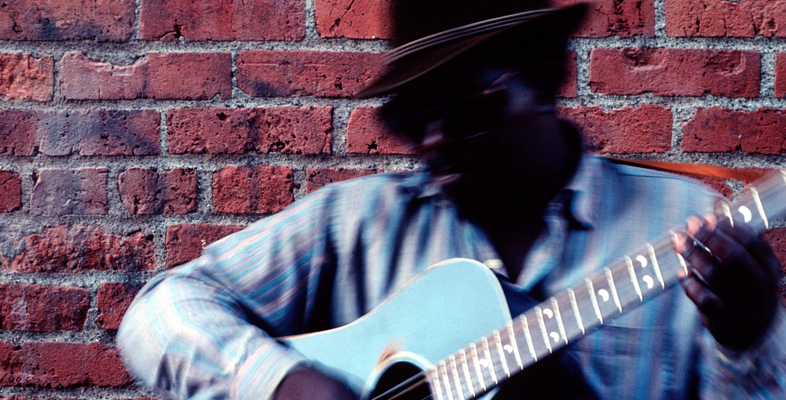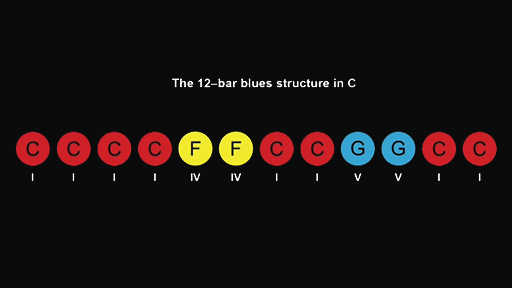12.3 12-bar blues
As already mentioned, blues composer W.C. Handy claimed to have noticed a repetitive chord sequence in the plantation song that inspired him. The chord pattern that Handy noted down is a succession of primary chords in a specific order. It is now known as 12-bar blues and it is a structure understood by all jazz and popular musicians. It is not the only structure used in blues songs and there are many variants of it, but all of them contain the same basic ingredients.
When we listen to music often what strikes us first is the rhythm. If you tap your foot or nod your head, you are feeling a beat. In any music, beats are grouped, usually into twos, threes or fours and each group of two, three or four beats is called a bar. The 12-bar blues is defined by the order of the three primary chords and the way they are grouped by rhythm. Blues music is in common or 4/4 time, that is, each bar has four beats, usually at a moderate speed. The blues pattern takes up 12 bars of music (12 x 4 beats), and fits neatly with the common three-line verse structure of the lyrics as the 12 bars can be divided into three 4 bar sections. At its simplest, each verse finishes with the end of the 12-bar sequence, and the sequence is repeated for each verse of the lyrics.
Watch this video, which explains how the 12-bar blues structure works.

Transcript: Video 3
[MUSIC PLAYING]
[MUSIC PLAYING]
[MUSIC PLAYING]
[MUSIC PLAYING]
[MUSIC PLAYING]
[MUSIC PLAYING]
[MUSIC - BILL HALEY AND THE COMETS, "ROCK AROUND THE CLOCK"]
[MUSIC - BILL HALEY AND THE COMETS, "ROCK AROUND THE CLOCK TONIGHT"]
In the video you saw a graphic representation of the 12-bar blues sequence. Look at it again now, to remind yourself of the pattern. If you have access to a musical instrument, you could try it out yourself.
As you will have seen from the video, this chord pattern became an important element in the foundation of jazz and of later styles of popular music including rhythm and blues and rock and roll. Many pieces of music that today we might recognise as typical rock and roll songs or ‘jazz standards’ use structures that are derived from the blues. If you would like to build a playlist of music that uses 12-bar blues, start with Bill Haley’s ‘Rock around the clock’, Duke Ellington’s ‘C-jam blues’, Louis Armstrong’s ‘West end blues’, Johnny Cash’s ‘Folsom prison blues’ and Robert Johnson’s ‘Sweet home Chicago’. These are just some examples that will give you an idea of how versatile the 12-bar blues structure is. Keep the graphic handy so you can follow the pattern of chords as you listen to these songs. This will help you become more familiar with how it sounds and help you to recognise it in other songs you listen to.

